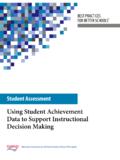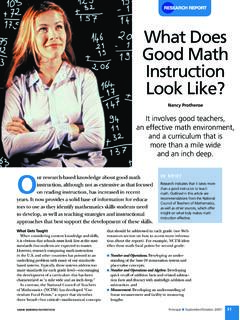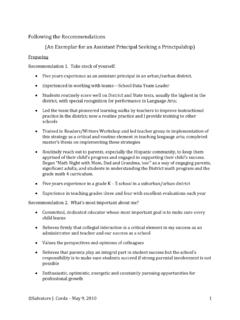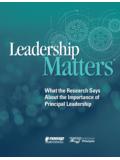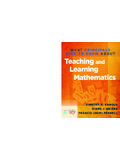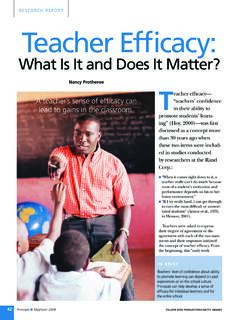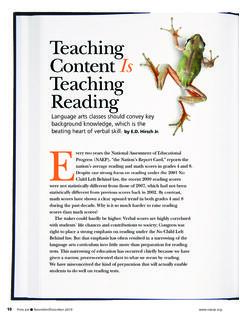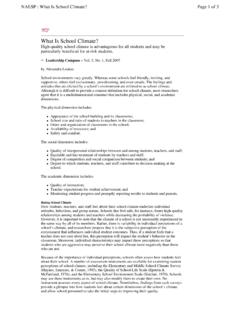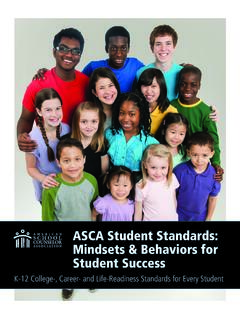Transcription of Learning Strategies as a Key to Student Success - NAESP
1 Franklin n November/December 200833researcH reportTeaching metacognitive skills to students , including those with Learning disabilities, improves their academic schools and classrooms across the country, educators are working to raise the achievement of all students to ever-higher levels. Yet, often missing in discussions about how to raise academic performance is the way in which individual students go about Learning . One aspect of a Student s approach to Learning is his or her use of Learning Strategies as a Key to Student Successnancy protheroe and suzanne clarke34 Principal n November/December 2008 Franklin and Deshler (2006) define a Learning strategy as an individ-ual s approach to a task.
2 It includes how a person thinks and acts when plan-ning, executing, and evaluating per-formance on a task and its outcomes. Much of this thinking about Learning is done unconsciously. For example, most of us automatically slow down when reading content that is difficult for us to understand. We also make use of a vari-ety of Strategies for helping us organize and remember both key elements of the Learning with many characteristics about people, however, there is wide variation in terms of the number of Learning Strategies we know and how well we use them.
3 For example, think of a Student you have known who approached new types of tasks with enthusiasm and who was typically able to figure out how to apply what he or she already knew to tackling a new problem. Now think about another child who reads a textbook but, when asked to sum-marize the main points in the chapter, can present only a disjointed list of thoughts with little sense of how they fit together. In math, this child might use only one strategy when approach-ing a problem even when that meth-od repeatedly , the difference between these two children is neither cognitive ability nor content knowledge.
4 Instead, the second child lacks metacognitive skills. Activities such as planning, moni-toring comprehension, and evaluating progress toward completion of a learn-ing task are metacognitive in nature. students with better-developed meta-cognitive skills typically have a better sense of their own strengths and needs related to the Learning process. They have a larger repertoire of Learning Strategies again, many of them used almost unconsciously. And perhaps most importantly, they are likely to select and use the Learning strategy that is most effective in helping them address a particular Learning Wang, Haertel, and Walberg (1993/1994) can help us understand just how important such metacognitive skills are to Student learn-ing.
5 They created a knowledge base of 11,000 statistical findings from a wide range of studies on Student Learning . Their intent was to identify the relative strength of the contribution of several major factors. They found that Student aptitude was the most influential of the six broad types of influences. Among the categories of Student aptitude, a Student s metacognitive processes that is, a Student s capacity to plan, monitor, and, if necessary, re-plan Learning strat-egies had the most powerful effect on his or her Learning . An increasingly strong research base points to the potential of strategy instruction to help support struggling learners, including students with learn-ing disabilities.
6 Specifically, teaching students how to use Learning Strategies , and helping them choose and imple-ment them effectively, helps to strength-en their metacognitive abilities and this, in turn, connects to improved stu-dent Learning . Good strategy instruction also can help. For example:n Improve Student performance, especially of students who have not previously developed effective meta-cognitive skills;n Increase Student independence and engagement with Learning ; andn Help students realize that it is sometimes the use of ineffective Strategies not lack of ability that hinders last factor is especially important because it may help to increase moti-vation.
7 students who have repeatedly experienced failure in school due to a lack of tools that can help them approach Learning efficiently are likely to become less persistent in addressing school tasks. Acquiring some additional tools Learning Strategies increases their likelihood of Success , and may also increase their willingness to take on new to teach Learning Strategies Researchers and practitioners who have studied and applied Learning strat-egy instruction in the classroom gener-ally agree on the how of instruction (Clarke, 2008).
8 Three components n November/December 2008of the skill are considered essential knowledge of what the strategy is, how to apply it, and when and where to use it (Jones, Polincsar, Ogle, & Carr, 1987). Effective instruction must address all three , Learning skills are most effec-tively taught in the context of content-area instruction. Perkins-Gough (2002) discusses some related findings of the Rand Reading Study Group, specifically:Teachers foster comprehension development when they connect comprehension strategy instruction with in-depth Learning of con-tent in such disciplines as history and sci-ence.
9 If students learn that these Strategies are tools for understanding the ideas in texts, then the Strategies become purposeful and integral reading students are helped to develop Learning Strategies in the context of Learning about content, they:n Receive more opportunities for teacher support than they would if the instruction was provided only during pullout classes or special sessions focusing on study skills instruction; andn Have more and more meaning-ful opportunities to practice the , there are three caveats to meshing strategy and content area instruction.
10 The first is that only one new element should be presented at a time. Thus, instruction on a new strat-egy should be presented in the context of familiar content. Otherwise, strug-gling students are likely to overload and be unlikely to learn either the strategy or the , the skills taught and the approaches used to teach them should be age- and grade-appropriate. For example, the metacognitive skill of summarizing might be addressed with primary-grades children by small-group discussions about a story, with the teach-er writing down Student comments.
